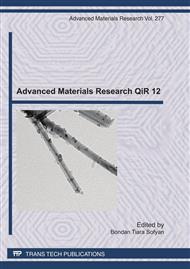[1]
L.L. Hench, Biomaterials: a forecast for the future, Biomaterials Vol 19 (1998), p.1419.
Google Scholar
[2]
I. Sopyan, M. Mel, S. Ramesh, and K. A. Khalid, Porous hydroxyapatite for artificial bone applications, Science and Technology of Advanced Materials Vol 8 (2007), p.116.
DOI: 10.1016/j.stam.2006.11.017
Google Scholar
[3]
L. Hong and X. Hengchang, Tensile strength of the interface between hydrokyapatite and bone. J Biomed Mater Res Vol 26 (1992), p.7. –18.
Google Scholar
[4]
A. J. Salgado, O. P. Coutinho, and R. L. Reis, Bone tissue engineering: state of the art and future trends, Macromol. Biosci., Vol 4 (2004), pp.743-765.
DOI: 10.1002/mabi.200400026
Google Scholar
[5]
S. Yang, K. F. Leong, Z. Du, and C. K. Chua, The design of scaffolds for use in tissue engineering. Part I. Traditional factors, Tissue Eng., Vol 7 (2001), pp.679-689.
DOI: 10.1089/107632701753337645
Google Scholar
[6]
K. J. Burg, S. Porter, and J. F. Kellam, Biomaterial development for bone tissue engineering, Biomaterials, Vol 21 (2000), pp.2347-2359.
DOI: 10.1016/s0142-9612(00)00102-2
Google Scholar
[7]
Joint Committee on Powder Diffraction Standards (JCPDS), International Center for Diffraction Data, Swathmore, PA.
Google Scholar
[8]
W. Suchanek, and M. Yoshimura, Processing and properties of hydroxyapatite-based biomaterials for use as hard tissue replacement implants, J. Mater. Res., Vol 13, (1998), pp.94-117.
DOI: 10.1557/jmr.1998.0015
Google Scholar
[9]
B. D. Cullity, Elements of X-Ray Diffraction, 1st Edition. Addison-Wesley Publishing Company, Inc. (1978).
Google Scholar
[10]
S. Sasikumar, and R. Vijayaraghavan, Low Temperature Synthesis of Nanocrystalline Hydroxyapatite from Egg Shells by Combustion Method, Trends Biomater. Artif. Organs, Vol 19, (2006), pp.70-73.
Google Scholar
[11]
S. R. Krishna, C. K. Chaitanya, S. K. Seshadri, and T. S. S. Kumar, Fluorinated Hydroxyapatite by Hydrolysis under Microwave Irradiation. Trends Biomater. Artif. Organs., Vol 16, (2002), pp.15-17.
Google Scholar
[12]
P. Wobrauschek, G. Pepponi, C. Streli, C. Jokubonis, G. Falkenberg and W. Osterode, SR-XRF Investigation Of Human Bone, JCPDS-International Centre for Diffraction Data 2002, Advances in X-ray Analysis, Vol 45, (2002), pp.478-484.
DOI: 10.1154/1.1779841
Google Scholar
[13]
F. Peters, K. Schwars, and M. Epple, The Structure of Bone Studied with Synchrotron X-ray Diffraction, X-ray Absorption Spectroscopy and Thermal Analysis, Thermochimica Acta, Vol 361, (2000), pp.131-138.
DOI: 10.1016/s0040-6031(00)00554-2
Google Scholar
[14]
R. Murugan, T.S.S. Kumar and P.K. Rao, Fluorinated Bovine Hydroxyapatite: Preparation and Characterization. Materials Letters, Vol 57, (2002), pp.429-433.
DOI: 10.1016/s0167-577x(02)00805-4
Google Scholar
[15]
S. Joschek, B. Nies, R. Krotz and A. Gofpferich, Chemical and Physicochemical Characterization of Porous Hydroxyapatite Ceramics Made of Natural Bone. Biomaterials, Vol 21, (2000), pp.1645-1658.
DOI: 10.1016/s0142-9612(00)00036-3
Google Scholar
[16]
F.H. Lin, C.J. Liao, K.S. Chen and J.S. Sun, Preparation of a biphasic porous bioceramic by heating bovine cancellous bone with Na4P2O7 · 10H2O addition, Biomaterials, Vol 20, (1999), pp.475-484.
DOI: 10.1016/s0142-9612(98)00193-8
Google Scholar


